ORDER
Pelecaniformes
FAMILY
Sulidae
GENUS & SPECIES
KEY FEATURES
• Glides over the ocean for hours
on end, “riding” the I rising currents of air deflected by the waves
• Hits the sea at 60 mph when diving after shoals of fish
• Stores its catch in a | throat pouch until it’s f ready to be swallowed
• Before it can fly, the single young leaves its nest and starts to swim south for the winter
WHERE IN THE WORLD?
Confined to the northern lAtlantic, breeding on [the coasts of Iceland, [Norway, France, Britain, Ireland and northeast Canada; winters at sea, south as far as the coasts of northern Africa and rthe southeastern U.S.
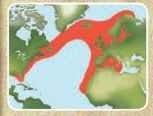
Lifecycle
The northern gannet spends much of its life in dashing flight at sea. But at its breeding colonies on land, it occupies its time in ritualized displays with its mate and neighbors.
HABITAT
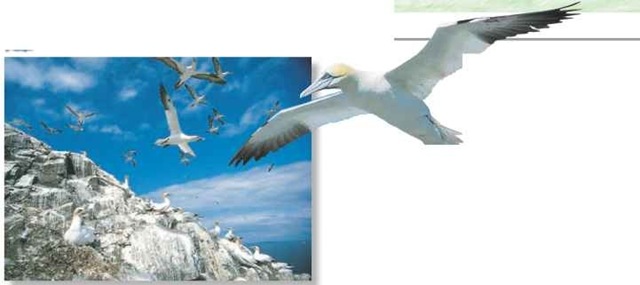
Where the wind blows Air rising against cliffs helps the heavy gannet take off on its 6′ wings.
CONSERVATION
In the last century, the northern gannet was killed for food, but legal protection ended this practice and it recovered. A recent threat is overfishing of the fish stocks on which it feeds.
The gannet wanders over open seas, often up to 90 miles from the coast, coming to land only to breed. It nests on offshore islands with steep cliffs in colonies known as gonnethes. From afar, a gannet island seems to be covered in snow because of the white birds and their guono (droppings).
Island-nesting has great advantages: the gannet is safe from predatory mammals and can fly in any direction in search of fish. It tracks seasonal movements of fish shoals, moving south to warmer parts of the Atlantic in autumn and returning in spring.
FOOD & FEEDING
Dive bomber
The gannet often plunges nearly 100′ to catch fish.

The gannet travels great distances to find rich feeding grounds. It spots shoals of fish while flying high over the sea, probably by the iridescent “oil slicks” shimmering on the surface that rise from the shoals. Then, arrowlike, the gannet dives vertically with its wings partly closed and plunges deep with a huge splash.
The gannet’s weight and diving speed thrusts it about 12′ below the surface, but it can paddle down to 50′ in pursuit of fish. It can even catch strong-swimming fish, such as mackerel. Small prey is swallowed at the surface before the gannet flies up to dive again and again.
• Almost three-quarters of all northern gannets, about 200,000 pairs, breed off the coasts of Britain and Ireland.
• Male gannets often have yellow stripes on the toes; females may have blue.
• The gannet can swallow four large mackerel one after another and may become too heavy to fly up from the sea’s surface.
• It takes 4-5 years for a juvenile to gain adult plumage, passing through ever-whiter stages.
BEHAVIOR
The gannet nests in huge colonies, and all the birds look almost identical; there’s little difference between sexes. It therefore uses a ritualized “language” of postures and calls to find its mate and keep neighbors at a distance.
A male claims ownership of his nest by calling loudly every time he returns to the colony and by displaying to neighboring males. He jabs the air with his bill, bows with wings raised, gapes menacingly and grapples bill-to-bill with rivals. Pairs communicate in gentler displays, such as bill fencing.
BREEDING
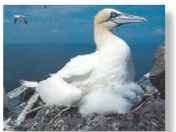
Mess of a nest Seaweed, feathers and guano make up the nest.
Early birds At dawn, the colony is already active.
At the start of the breeding season, the male brings nest material to his mate, which she binds together with droppings. They incubate their egg in alternating 30-36-hour sessions for 43 days.
The downy offspring is fed by both parents for 13 weeks.Too fat to fly and its wings not fully grown, it jumps into the sea to head south for winter by swimming and drifting with the current. It survives on fat reserves until it can fly and fish for itself.
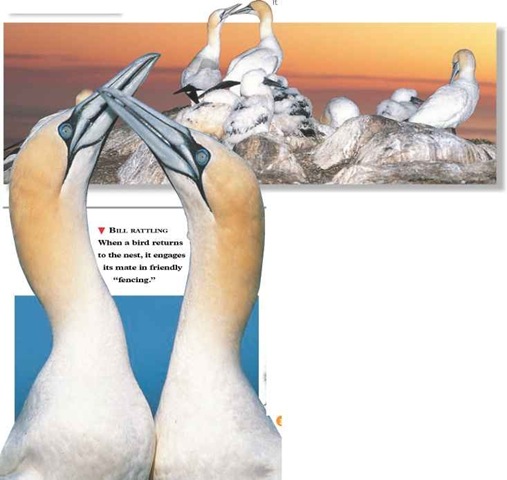
SIGN LANGUAGE
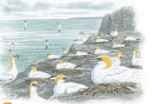
phinding the way…
A gannet colony is crowded, with thousands of similar-looking nests all only 3′ apart; an incoming bird uses landmarks to find its nest.

Token of esteem…
A male arrives with seaweed for his mate to add to the nest. The birds pair for life and use the same nest each year.

Good to see you…
Shaking their heads up and down and from side to side, as if in slow motion, the birds k strengthen their bond.

See you soon
One bird points to the sky to warn its mate that it’s about to leave. If both birds left, their egg or chick would be at great risk.
PROFILE
Northern Gannet
The northern gannet is equipped for life as a specialized fish-eater and flies great distances on its long wings to track down prey.
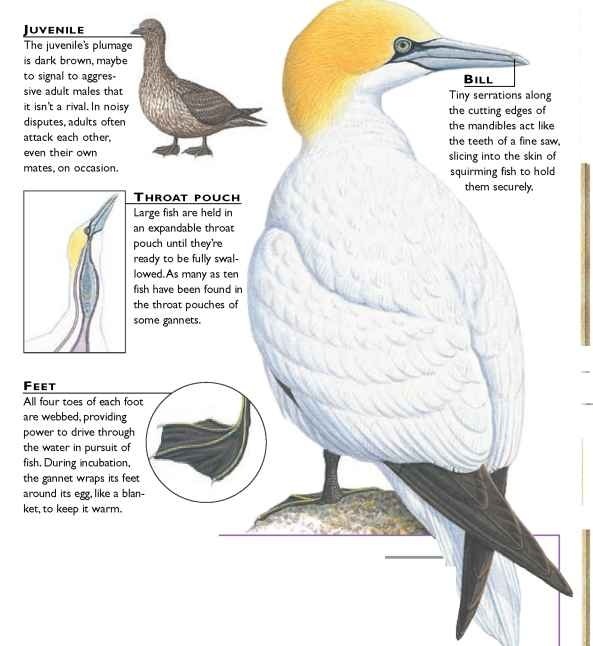
CREATURE COMPARISONS
Smaller than its relative the northern gannet, the masked booby (Sula dactylatra) or the blue-faced booby, ranges over all tropical oceans and nests on the flat, open ground of tropical islands.The booby is lighter than the northern gannet which lets this ^-long-winged bird take off from islands where there’s often very little wind to provide lift. Both species have a mainly brilliant white plumage, but the northern gannet has creamy-yellow feathers on its head. The masked booby also has black trailing edges on its wings and tail, whereas the gannet is black on its wing tips alone.
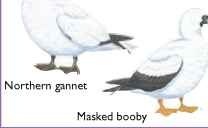
| VITAL | |
| STATISTICS | |
| Weight | 5-8 lbs. |
| Length | 3-3.3′ |
| Wingspan | 5.5-6′ |
| Sexual Maturity | 4-5 years |
| Breeding Season | April-September |
| Number of Eggs | |
| Incubation Period | 43 days |
| Fledging Period | 91 days |
| ‘Breeding Interval | 1 year |
| Typical Diet | Fish: mainly shoaling species, such as herring and mackerel |
| Lifespan | 15 years |
RELATED SPECIES
• There are 2 other species of gannet in the genus Sula: the Australian gannet, S. serrator, and : the Cape, or African, gannet, S. capensis. Both fish the same way as the northern gan-net, but in temperate oceans in the Southern Hemisphere. Sula also has 6 booby species: the blue-footed, red-footed, brown, masked, Peruvian and Abbott’s boobies. These birds take the place of gannets in tropical seas.

